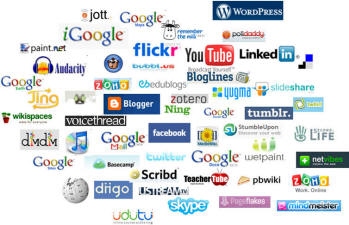25 Years of Edtech: 2006 – Web 2.0

(All you needed for a web 2.0 business was a logo, a disregard for users’ data, an aversion to vowels and a business plan that ended with “Get bought out”)
[Continuing the 25 Years of Ed Tech series]
The “web 2.0” tag gained popularity from Tim O’Reilly’s use in 2005, but not until around 2006 did the term begin to penetrate in educational usage, for example, this piece by Bryan Alexander highlighting the relevance of social and open aspects of its application. From one perspective it was simply a practical term to group together the user-generated content services, including YouTube, Flickr, and blogs. But it was also more than just a useful term for a set of technologies; it seemed to capture a new mindset in our relation to the internet. In his essay, O’Reilly set out the seven principles of web 2.0, which some took to be commandments handed down in stone (2.0) and the web 2.0 boom took off—followed by the consequent bust (it transpired that you did need a business plan after all).
Just as the fascination with e-learning had seen every possible term prefixed with “e,” so the addition of “2.0” to any educational term in the late 2000s made it fashionable. The collapse of the web 2.0 boom, and problems with some of the core concepts meant that by 2009 it was being declared dead. Inherent in much of the web 2.0 approach was a free service, which inevitably led to data being the key source for revenue, and gave rise to the oft quoted line that if you’re not paying for it, then you’re the product. As web 2.0 morphed into social media, the inherent issues around free speech and offensive behaviour came to the fore. In educational terms this raises issues about duty of care for students, recognising academic labor and marginalised groups. In the ‘anyone can make a web 2.0 business’ rush, the privileged Bro culture of Silicon Valley was reinforced. The utopia of web 2.0 turned out to be one with scant regard for employment laws, diversity or social responsibility. Get big numbers of users quickly and get bought out by Google was the only business model that really survived, and in that case, you don’t care about building long term relationships with a community.
Nevertheless, at the time, web 2.0 posed a fundamental question as to how education conducts many of its cherished processes. I wrote a rather pretentious paper on the implications of web 2.0 on Higher ed (what was I on with phrases like “the Topography of Formality”?), but some of the questions raised here are still relevant. Peer review, publishing, ascribing quality — all of these were founded on what David Weinberger referred to as filtering on the way in rather than on the way out. While the quality of much online content was poor, there was always an aspect of what was “good enough” for any learner. With the demise of the optimism around web 2.0, many of the accompanying issues it raised for higher education have largely been forgotten. But they were never really addressed, for instance while the open repository for physics publications, arXiv, and open access methods to publication became mainstream, the journal system is still dominant, and largely based on double blind, anonymous peer review.
Everyone (including me) is rather embarrassed now by the enthusiasm they felt for web 2.0 at the time, like one of those films that loads of people froth over and then a year later, deny ever liking (I’m looking at you La La Land). While this is understandable given the ridiculous hype that accompanied it, and the more we’ve come to appreciate the associated problems, there are still some core issues in terms of practice that education could benefit from, if they were stripped of the venture capital context. Integrating the participatory culture that web 2.0 brought to the fore is still a challenge and an opportunity for higher education.

2 Comments
Pingback:
Pingback: